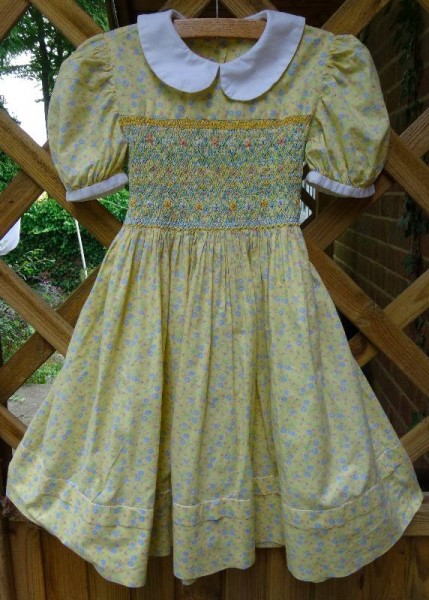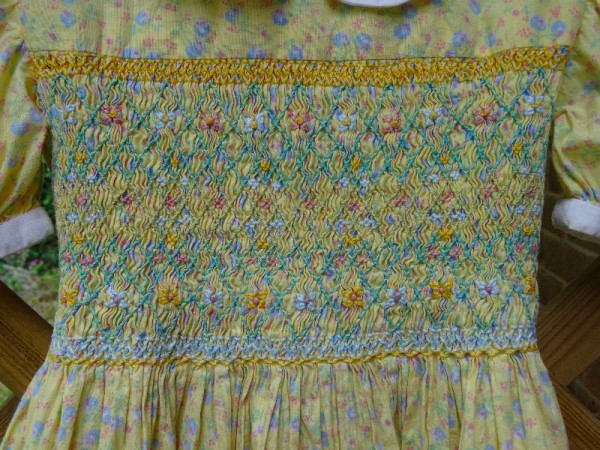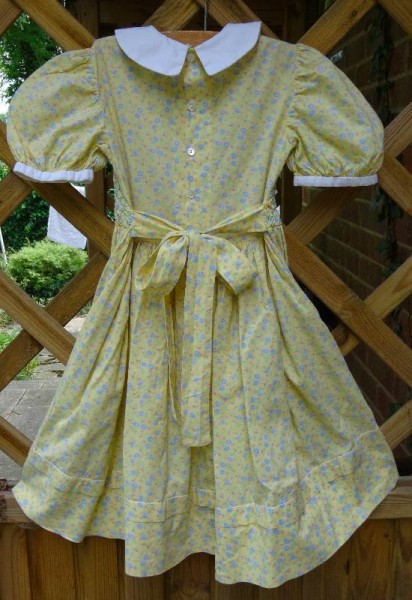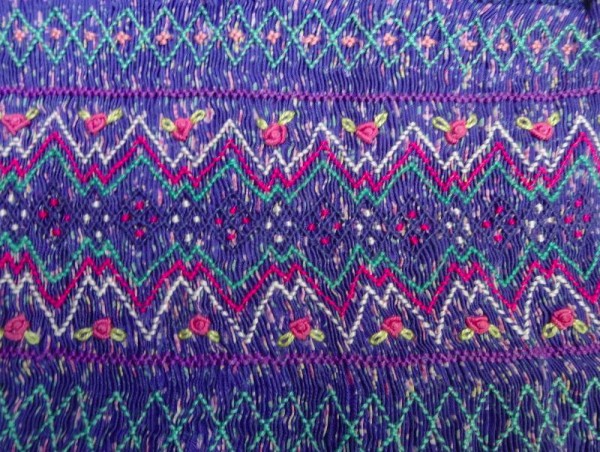Here is another thing ferreted out of trunks in a North Wales barn. This is the short-sleeved summer version of the smocked dress made from the pattern shown in the previous post. The collar and cuffs are in standard weight cotton and they would probably have been better if made from plain white lawn of the same weight at the dress fabric. Needs must, however, and at the time that was the only white I had.
I used a slightly thicker, twisted cotton to do the smocking as that was all I had in the colours I wanted to use. I never thought much about it at the time, so I suppose it must have looked ok but today I think it looks a bit lumpy and, if I were doing it now I would have preferred to use stranded embroidery thread to give it a smoother look.
I’m a bit of a fraud heading this post ‘smocked dresses’ for I never got beyond the smocking in the second of the summer dresses and only recently found all the pieces in the bottom of a pine chest. Now it may as well wait to be finished until a little one of the right age comes along.
As I’m still on nanny duty, I shall publish this post now but later shall add to both this and the previous one close ups of the fabrics which I forgot to photograph before I came to London. In the case of the Liberty prints, I shall then get in touch with Liberty to see whether they know the name of these classic prints.
I was trying to find a few references to heroines of children’s books wearing smocks but exhaustion and diving up blind literary alleys mean the only things I’ve come up with are counter to expectation. To be clear about the use of the term ‘smock’, I refer you back to what I wrote (at some length I’m afraid) here . Smocks might have smocking but they often didn’t. Smocking also came to appear on things like dresses, pinafores, blouses, etc., none of which are quite the same as smocks. You can have one without the other.
Google is very fond of linking searches for smocks/smocked dresses/smocking to Kate Greenaway, the C19th children’s illustrator who liked to depict children living in some paradise at least 50 years before her time and in a place whose reality lay solely in her own mind. If you look carefully at these pictures you’ll be hard pressed to see many smocked dresses, although there are plenty of rural style smocks without smocking, or with what looks like just a row or two of random gathers.
Then I thought of AA Milne, so I searched for images of Christopher Robin as drawn by E.H.Shepherd and blow me if Christopher Robin is often shown wearing a smock and sometimes even one with a hint of smocking. (He is definitely not to be seen in a T shirt and shorts as seen in Disney, although photographs of the child the character is based on show him either in Fairisle jumpers or in complicated shirts with big white collars and a loose floppy tie-like piece of fabric).
Perhaps, after all smocked dresses of the sort I’ve shown were quite a late development, at their most fashionable in the mid C20th. Do this little test – ask women you know who were born between the late 1940s and the late 1950s whether they ever had such a dress (probably white, definitely rosebuds) and further do they have a studio photograph of themselves in it. I have a feeling this was the Sunday best uniform for many a middle class girl and there I suspect you have it – from working agricultural smock to middle-class best in just over a century. Of course 60’s dress designers, like Mary Quant or Biba subverted things even further and smocks became high fashion for the trendy young right across the class spectrum – although it is true you had to be built like Christopher Robin/Twiggy to carry the fashion successfully.
(A late thought: did child star Shirley Temple wear smocked dresses? According to Google images, it seems not. Smocks, yes; smocked dresses, no).
Any thoughts?





16 Comments
Fascinating post Mary, and how interesting that the rural garb of agricultural workers was re-invented as whimsical childrenswear post Industrial Revolution, harking back with all the inaccuracy of nostalgia, to an imagined rural idyll that probably never existed. I saw a beautiful example of a farmer’s smock last year in the small museum attached to Abergavenny Castle (ruined) and from memory it certainly had smocking across the chest, so smocks and smocking came together in that example!
Yes, you’re right, that’s what I was trying to say. The rural/workman’s smock developed into something gloriously and individually decorated. Kate Greenaway harked back (in spirit more than accuracy) to the idea and nostalgia of the rural life and she wasn’t the only one. Thomas Hardy, also writing about a time 50 years before he was living, in ‘Far from the Madding Crowd’ has dear Gabriel Oak (forever Alan Bates in my mind) exchanging his overcoat for a regulation shepherd’s smock frock at a country fair in Dorset as he fails to land a job as a bailiff or superintendent. There are many wonderful smocks in the Museum of Rural Life in Reading like that you saw in Abergavenny (Google images for the Museum of Rural Life smocks). But then, on garments actually worn, as opposed to being useful indicators of times past, smocking seems to have gone out of fashion until resurrected as the must have style for little – mainly middle class – children and especially for portrait photography. In my post on smocking embroidery (everything apart from the smocking on a rural smock) on the christening dress, I try to chase the changing form and use of garments referred to as smocks. It all gets rather confusing. especially when smocks and shirts start swapping meanings.I may be talking nonsense…
I don’t think so! I read your linked post on smocking and it is fascinating that the smocking motifs represented the different workers’ occupations. I think Shetland and Guerney knitters did the same, often carrying a family motif or specific stitch or cable through all their knitted sweaters etc. This I believe, as well as being decorative and individual, also served a sad but necessary function; when men were lost at sea, if bodies were washed up, the sweaters could help identify victims if the bodies were unrecognisable.
Interesting… I had not thought about the origin of the smocked little girl’s dress. I certainly had dresses with smocking on as a child. I still have the smocked baby dress that was mine – a few holes here and there but definitely smocking, I do not know who made it although my Mother was a talented sewer. Now, I am bravely going to say that I must have worn it around 1953!!!! There, it is done….
I won’t tell anybody! But there you are you fall bang into my period for smocking revival.
My sister and I were born in the 1940’s and the dresses I remember (there must have been others as our mother enjoyed smocking) were in blue and white flower-patterned ‘Dayella’ and of course my memory is reinforced by a studio portrait.
Interesting, thanks for replying. I remember hearing of Dayella but can’t find anything about it – was it more cotton and less wool than Clydella?? Questions, questions.I’m tucking this to the back of my mind hoping to come across something when researching something quite different – as often happens.
In Mabel Dearmer’s Noah’s Ark Geography (1900) the small boy, Kit, is shown in the author’s illustrations, which match her witty prose in their elegance, wearing a garment which looks loke a smock.
I remember reading somewhere that the Hardy type smock, like the Guernsey sweater and the academic gown, is a garment which is composed entirely of rectangular pieces. In the case of the agricultural smock , the smocking is not only decorative but also gives an elasticated fit over the chest.
Ah, Percy Dearmer’s wife (Percy was the author of the very useful’The Parson’s Manual’, a handbook for Anglican priests and the much loved ‘English Hymnal’). I think the little boy is wearing a smock but again, rather like Kate Greenaway, the artist isn’t interested in showing any detail. Mabel – another of those forgotten women artists – was a wonderful illustrator of strong line and glorious blocks of colour and at a time when book illustration, especially for children, was particularly stunning.I love the cover for ‘Wymps’
I think you’re right about unsophisticated construction shapes for smocks, guernseys, early academic dress
I have, but no longer wear, an adult Laura Ashley dress which is machine smocked.
Somewhat off the point is a notice once displayed in a local supermarket advertising “smocked mackerel”. It did suggest a rather nice image of stripy fish in their smock frocks.
What a lovely image!
Thank you for your comment on my comment. Yes, Dayella had a higher percentage of cotton than Viyella at least. As for Clydella I’ve come across it comparatively recently (buying check shirts in charity shops to re-use the material), but still I’d forgotten about it. Oh I do love these reminders of the past when they’re accompanied by information that’s quite new to me. Thank you.
It is funny how often what one finds out contradicts what one thought one knew – I’m constantly being surprised at how irritatingly vague my ideas are and delighted when I feel I’ve sorted even a few of them out.
Statistically, a bet on the Banker winning has the highest odds of accomplishment, as the the bank has a slight edge.
I have read several excellent stuff here. Certainly price bookmarking for
revisiting. I surprise how so much attempt you set to create any such wonderful informative website.
Great article. Your perspective is refreshing.
Looking forward to more
One Trackback
fun88
Smocking 3: girls summer dresses in Laura Ashley lawn – Addison Embroidery at the Vicarage